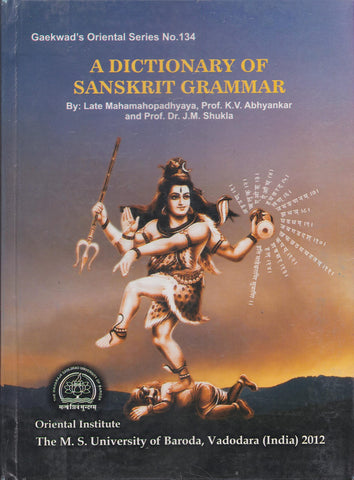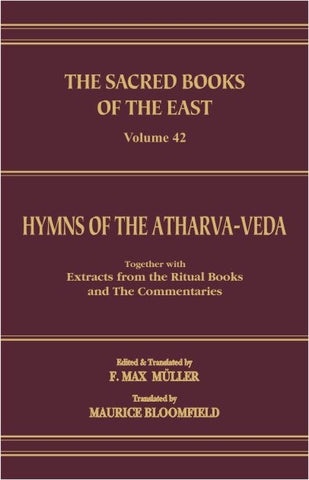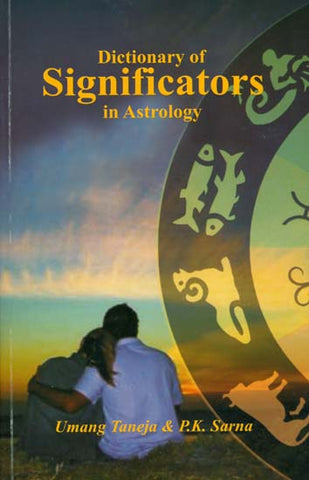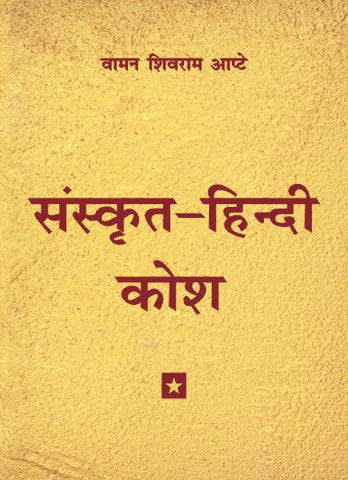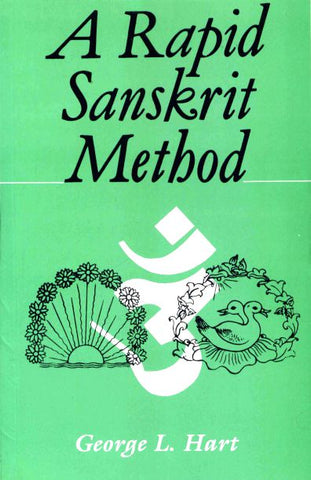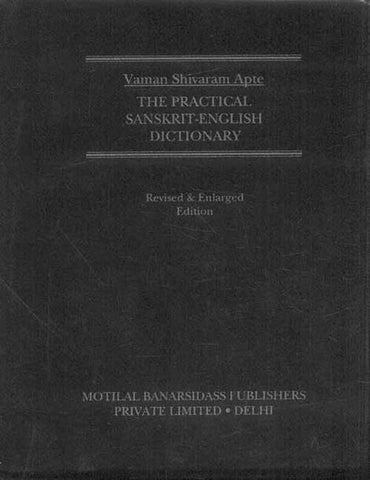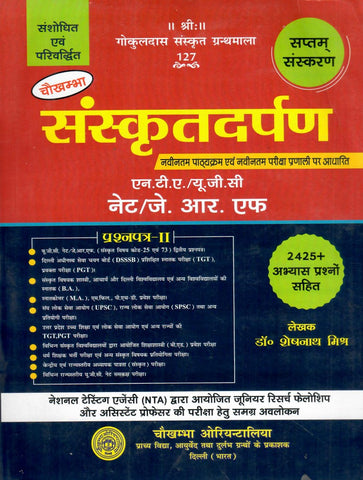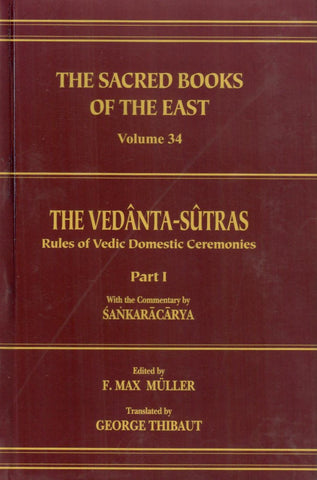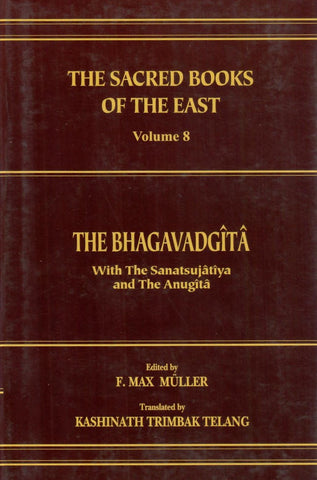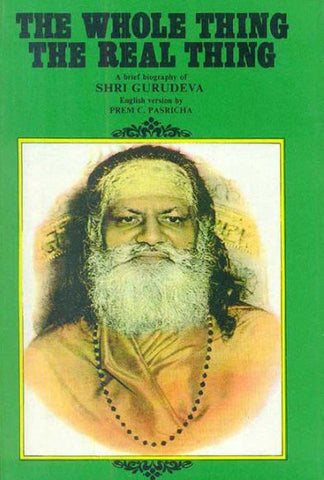Your cart is empty now.
Ten years have elapsed since the first part of my translation of Gaina Sutras appeared. During that decennium many and very important additions to our knowledge of Gainism and its history have been made by a small number of excellent scholars. The text of the canonical books, together with good commentaries in Sanskrit and Guzerati, has been made accessible in fair editions published by native scholars in India. Critical editions of two of them have been published by Professors Leumann and Hoernle and the latter scholar has added a careful translation and ample illustrations to his edition of the text. A general survey of the whole Gaina literature has been given by Professor Weber in his catalogue of the Berlin Manuscripts and in his learned treatise on the sacred literature of the Gainas. The development of Gaina learning and science has been studied by Professor Leumann, and some Gaina legends and their relations to those of the Brahmans and Buddhists have been investigated by the same scholar. An important document for our knowledge of the old history of the Svetarnbara sect has been edited by myself, and the history of some of their Gakkhas has been made known from their lists of teachers by Hoernle and Klatt. The last-named scholar, whom we have all but lost by this time, has prepared a biographical dictionary of all Gaina writers and historical persons, and he has issued specimens of this great Onomasticon, while Hofrat Buhler has written a detailed biography of the famous encyclopaedist Hernakandra. The same scholar has deciphered the ancient inscriptions, and discussed the sculptures excavated by Dr. Fuhrer at Mathura, and the important inscriptions at Sravana Belgola have been edited by Mr. Lewis Rice ; M. A. Barth has reviewed our knowledge of Gainism, and likewise Buhler in a short paper. Lastly Bhandarkar has given a most valuable sketch of the whole of Gainism. All these additions to our knowledge of Gainism (and I have but mentioned the most remarkable ones) have shed so much clear light on the whole subject that little room is left now for mere guesswork, and the true historical and philological method can be applied to all its parts. Still some of the principal problems require elucidation, while the proffered solution of others is not accepted by all scholars. I, therefore, gladly avail myself of this opportunity to discuss some of the disputed points, for the settling of which the works translated in this volume offer valuable materials.
It is now admitted by all that Nataputta (Gnatriputra), who is commonly called Mahavira or Vardhamana, was a contemporary of Buddha; and that the Niganthas 8(Nirgranthas), now better known under the name of Gainas or Arhatas, already existed as an important sect at the time when the Buddhist church was being founded. But it is still open to doubt whether the religion of the early Nirgranthas was essentially the same as that taught in the canonical and other books of the present Gainas, or underwent a great change up to the time of the composition of the Siddhanta. In order to come nearer the solution of this question, it may be desirable to collect from the published Buddhist works, as the oldest witnesses we can summon, all available information about the Niga1ttltas, their doctrines and religious practices.
In the Anguttara Nikaya, III, 74, a learned prince of the Likkhavis of Vaisali, Abhaya gives the following account of some Nigantha doctrines: 'The Nigantha Nataputta, sir, who knows and sees all things, who claims perfect knowledge and faith (in the following terms): "walking and standing, sleeping or waking, I am always possessed of perfect knowledge and faith;" teaches the annihilation by austerities of the old Karman, and the prevention by in activity of new Karman. When Karman ceases, misery ceases; when misery ceases, perception ceases ; when perception ceases, every misery will come to an end. In this way a man is saved by pure annihilation of sin (niggara) which is really effective.
The Gaina counterpart to these tenets can be collected from the Uttaradhyayana XXIX. ‘By austerities he cuts off Karman,' § 27. 'By renouncing activity he obtains inactivity; by ceasing to act he acquires no new Karman, and destroys the Karman he had acquired before,' § 37. The last stages in this process are fully described in §§ 71, 72. And again, in XXXII, v. 7, we read: 'Karman is the root of birth and death, and birth and death they call misery.' The nearly identical verses 34,47,60, 73, 86, 99 may be thus condensed: 'But a man who is indifferent to the object of the senses, and to the feelings of the mind [this comes nearest to the Buddhist vedana, perception], is free from sorrows; though still in the Samsara, he is not afflicted by that long succession of pains just as the leaf of the Lotus (is not, moistened) by water.'
The above assertion that Nataputta claimed the possession of perfect knowledge and faith, requires no further proof; for it is one of the fundamental dogmas of the Gainas.
Another piece of information about Nigantha doctrines may be gathered from the Mahavagga VI, 3 (S. B. E., vol. xvii, p. 108 ff.) There a story is told of Siha, the general of the Likkhavis, who was a lay disciple of Nataputta. He wanted to pay the Buddha a visit, but Nataputta tried to dissuade him from it, because the Niganthas held the Kriyavada, while the Buddha taught the Akriyavada, Siha, however, setting his master's prohibition at nought, went to the Buddha on his own account, and was, of course, converted by him. Now the statement that the Niganthas embraced the Kriyavada is borne out by our texts; for in the Sutrakritanga I, 12, 21, below, p. 319, it is said that a perfect ascetic' is entitled to expound the Kriyavada ;' and this doctrine is thus expressed in the Akaranga Sutra I, I, 1, 4 (part i, p. 2): 'He believes in soul, believes in the world, believes in reward, believes in action (believed to be our own doing in such judgments as these): "I did it;" "I shall cause another to do it;" " I shall allow another to do it." ,
Another lay disciple of Mahavira, converted by the Buddha, was Upali. As narrated in the Magglzima Nikaya 56, he ventured upon a dispute with him whether the sins of the mind are heaviest. as the Buddha teaches. or the sins of the body, as the Nigantha Nataputta contends. In the beginning of the discourse Upali states that his master uses the term danda, punishment, for what is commonly called kamma, deed, act. This is true, though not quite to the letter; for the word kamma occurs also in the Gaina Sutras in that sense. The term danda, however, is at least as frequently used. Thus, in the Sutrakritanga II, 2, p. 357 ff., the thirteen kinds of 'committing sins' are treated of, and in the first five cases the word which I have translated 'committing sins' is in the original dandasamadane, and in the remaining cases kiriyathan e, i. e. kriyasthana.
| Introduction | xiii | |
| Uttaradhyayana | ||
| Lecture 1 | On discipline (especially for pupils) | 1 |
| Lecture 2 | On troubles. (About the twenty-two things that cause trouble to monks) | 8 |
| Lecture 3 | The four requisites (for the attainment of beatitude) | 15 |
| Lecture 4 | Impurity. (Carefulness required for obtaining the end). | 18 |
| Lecture 5 | Death against (and with) one's will | 20 |
| Lecture 6 | The false ascetic. (Wrong conduct leads to perdition, right conduct to salvation) | 24 |
| Lecture 7 | The parable of the ram, &c. (illustrative of the folly of the sinner who misses his chance of reaching a more exalted state of existence) | 27 |
| Lecture 8 | Kapila's verses (in praise of good conduct) | 31 |
| Lecture 9 | The Pravragya of king Nami. (A dialogue between him and Indra who advised him to retain the royalty) | 35 |
| Lecture 10 | The leaf of the tree. (A sermon by Mahavira on the punishment of the sinner and the reward of the righteous) | 41 |
| Lecture 11 | The very learned (monk; his virtues and his superiority) | 46 |
| Lecture 12 | Harikera, (a Kandala, turned monk; his victory over a Brahman, whom he converts) | 50 |
| Lecture 13 | Kitra and SambhUta. (A dialogue on the vanity of worldly pleasures) | 56 |
| Lecture 14 | Ishukdra. (A legend, illustrating the excellence of a monastic life) | 61 |
| Lecture 15 | The true monk; (how he should conduct himself) | 69 |
| Lecture 16 | The ten conditions of perfect chastity | 73 |
| Lecture 17 | The bad Sramana; (what a monk should avoid) | 77 |
| Lecture 18 | Sangaya. (King S. turned monk; he preaches that the state of a monk is preferable to that of a king; illustrations from Gaina history) | 80 |
| Lecture 19 | The son of Mriga. (On the punishment in the hells) | 88 |
| Lecture 20 | The great duty of the Nirgranthas. (A dialogue between king Srenika and a monk on the happiness obtained by righteousness. The bad monk is lost) | 100 |
| Lecture 21 | Samudrapala, (turned monk. On the duties of a monk) | 108 |
| Lecture 22 | Rathanerni. (The renunciation of Arishtranemi, his wife Ragimati exhorts Rathanerni) | 112 |
| Lecture 23 | Kesi and Gautama. (The followers of Parrva are brought over to the church of Mahavira) | 119 |
| Lecture 24 | The Samitis (and the Guptis) | 129 |
| Lecture 25 | The true sacrifice. (GayaghOsha, the monk, converts Vigayaghosha, the Brahman) | 136 |
| Lecture 26 | The correct behaviour (of monks during the several parts of day and night) | 142 |
| Lecture 27 | The bad bullocks (compared to bad pupils by Garga) | 149 |
| Lecture 28 | The road to final deliverance. (On the fundamental principles of Gainism) | 152 |
| Lecture 29 | The exertion in righteousness. (On the seventy-three articles necessary for reaching perfection) | 158 |
| Lecture 30 | The road of penance. (On external and internal austerities) | 174 |
| Lecture 31 | Mode of life. (A list of articles of the Gaina faith according to the number of their subdivisions) | 180 |
| Lecture 32 | The causes of carelessness; (what excites the passions and produces Karman) | 184 |
| Lecture 33 | The nature of Karman, (and the subdivisions of it) | 192 |
| Lecture 34 | On Lesya | 196 |
| Lecture 35 | The houseless monk. (The cheif duties of a monk) | 203 |
| Lecture 36 | On living beings and things without life. (The contents of this Lecture are detailed in note 2, pp. 206, 207) | 206 |
| Sutrakritanga | ||
| First Book | ||
| Lecture 1 | The doctrine. (On some heretical doctrines) | 235-248 |
| (Materialists, v. 8; Vedantins, v. 9; other materialists, vv. I I, 12; Akriyavdins, v. 13; forerunners of the Vaiseshikas.v. 15; Bauddhas, v. 17; Ganayas, v, 18) | 235 | |
| (Fatalists, vv. 1-3; Agnostics, v. I7; Kriyavadins, v. 24; Buddhists, vv. 25-28, cf. p. 414) | 239 | |
| (Pauranikas, vv. 6-8; the followers of Gosala, vv. r r , 12; Vainayikas, v. 14) | 243 | |
| (Some popular beliefs, vv. 6, 7 Conclusion) | 246 | |
| Lecture 2 | The destruction of Karrnan ; (how to lead a holy life) | 249-261 |
| Chapter 1 | 249 | |
| Chapter 2 | 253 | |
| Chapter 3 | 257 | |
| Lecture 3 | The knowledge of troubles | 261-271 |
| Chapter 1 | (A monk encounters many difficulties) . | 261 |
| Chapter 2 | (He is tempted back to domestic life) | 263 |
| Chapter 3 | (He easily desponds. The opinion refuted that a monk should not provide a sick brother with food) | 265 |
| Lecture 3 | Chapter 4. (Several objections removed) | 268 |
| Lecture 4 | Knowledge of women | 271-278 |
| Chapter 1. | (How women tempt a monk) | 271 |
| Chapter 2. | (How they treat him afterwards) | 275 |
| Lecture 5 | Description of the hells . | 279-286 |
| Chapter 1. | 279 | |
| Chapter 2. | 283 | |
| Lecture 6 | Praise of Mahavira | 287 |
| Lecture 7 | Description of the wicked. (No living beings should be destroyed; no merit in ablutions and tending the sacrificial fire. A monk should not be selfish) | 292 |
| Lecture 8 | On exertion. (Exertion not leading to works recommended) | 297 |
| Lecture 9 | The Law. (What a monk should abstain from) | 301 |
| Lecture 10 | Carefulness. (Some more injunctions and prohibitions) | 306 |
| Lecture 11 | The Path. (The same subject continued and concluded) | 310 |
| Lecture 12 | The creed. (On the four heresies: Agnosticism, v. 2; Vinayavdda, v. 3 ; Akriyavdda, vv. 4-10; Kriyavada, v. I I ff.) | 315 |
| Lecture 13 | The real truth. (Some duties of a pious monk) | 320 |
| Lecture 14 | The Nirgrantha. (The same subject continued) | 324 |
| Lecture 15 | The Yamakas. (Miscellaneous topics treated in artificial verses) | 329 |
| Lecture 16 | The song. (On the virtues of a true monk) | 333 |
| Second Book | ||
| Lecture 1 | The Lotus. (The parable of the Lotus. The Materialists, § 14 ff. Another school of Materialists and the forerunners of the Vaiseshikas, § 20 ff. The Vedintins, § 25 ff. The fatalists, § 30 ff. Exhortation to follow the true Law, § 35 ff.) | 335 |
| On activity. (The twelve kinds of committing sin, and sinless actions. Some wicked practices described, § 25 ff. Some more wicked practices, § 60 ff. Right conduct of monks, § 69 ff.; of laymen, § 75 ff. Re- futation of the 363 heretical philosophical sch | 355 | |
| Knowledge of food. (On the generation of living beings) . | 388 | |
| Renunciation of activity. (An action is sinful though it be done unconsciously) | 398 | |
| Freedom from error; (what should be maintained and what not) | 405 | |
| Ardraka; (his dispute with Gosala, a Buddhist, a Vedic priest, a Vedantin, and a Hastitapasa) | 409 | |
| Nalanda. (Udaka, a follower of Parsva, is converted by Gautama) | 419 | |
| Index of Names and Subjects | 437 | |
| Index of Sanskrit and Prakrit Words | 443 | |
| Transliteration of Oriental Alphabets adopted for the Translations of the Sacred Books of the East | 453 |
Ten years have elapsed since the first part of my translation of Gaina Sutras appeared. During that decennium many and very important additions to our knowledge of Gainism and its history have been made by a small number of excellent scholars. The text of the canonical books, together with good commentaries in Sanskrit and Guzerati, has been made accessible in fair editions published by native scholars in India. Critical editions of two of them have been published by Professors Leumann and Hoernle and the latter scholar has added a careful translation and ample illustrations to his edition of the text. A general survey of the whole Gaina literature has been given by Professor Weber in his catalogue of the Berlin Manuscripts and in his learned treatise on the sacred literature of the Gainas. The development of Gaina learning and science has been studied by Professor Leumann, and some Gaina legends and their relations to those of the Brahmans and Buddhists have been investigated by the same scholar. An important document for our knowledge of the old history of the Svetarnbara sect has been edited by myself, and the history of some of their Gakkhas has been made known from their lists of teachers by Hoernle and Klatt. The last-named scholar, whom we have all but lost by this time, has prepared a biographical dictionary of all Gaina writers and historical persons, and he has issued specimens of this great Onomasticon, while Hofrat Buhler has written a detailed biography of the famous encyclopaedist Hernakandra. The same scholar has deciphered the ancient inscriptions, and discussed the sculptures excavated by Dr. Fuhrer at Mathura, and the important inscriptions at Sravana Belgola have been edited by Mr. Lewis Rice ; M. A. Barth has reviewed our knowledge of Gainism, and likewise Buhler in a short paper. Lastly Bhandarkar has given a most valuable sketch of the whole of Gainism. All these additions to our knowledge of Gainism (and I have but mentioned the most remarkable ones) have shed so much clear light on the whole subject that little room is left now for mere guesswork, and the true historical and philological method can be applied to all its parts. Still some of the principal problems require elucidation, while the proffered solution of others is not accepted by all scholars. I, therefore, gladly avail myself of this opportunity to discuss some of the disputed points, for the settling of which the works translated in this volume offer valuable materials.
It is now admitted by all that Nataputta (Gnatriputra), who is commonly called Mahavira or Vardhamana, was a contemporary of Buddha; and that the Niganthas 8(Nirgranthas), now better known under the name of Gainas or Arhatas, already existed as an important sect at the time when the Buddhist church was being founded. But it is still open to doubt whether the religion of the early Nirgranthas was essentially the same as that taught in the canonical and other books of the present Gainas, or underwent a great change up to the time of the composition of the Siddhanta. In order to come nearer the solution of this question, it may be desirable to collect from the published Buddhist works, as the oldest witnesses we can summon, all available information about the Niga1ttltas, their doctrines and religious practices.
In the Anguttara Nikaya, III, 74, a learned prince of the Likkhavis of Vaisali, Abhaya gives the following account of some Nigantha doctrines: 'The Nigantha Nataputta, sir, who knows and sees all things, who claims perfect knowledge and faith (in the following terms): "walking and standing, sleeping or waking, I am always possessed of perfect knowledge and faith;" teaches the annihilation by austerities of the old Karman, and the prevention by in activity of new Karman. When Karman ceases, misery ceases; when misery ceases, perception ceases ; when perception ceases, every misery will come to an end. In this way a man is saved by pure annihilation of sin (niggara) which is really effective.
The Gaina counterpart to these tenets can be collected from the Uttaradhyayana XXIX. ‘By austerities he cuts off Karman,' § 27. 'By renouncing activity he obtains inactivity; by ceasing to act he acquires no new Karman, and destroys the Karman he had acquired before,' § 37. The last stages in this process are fully described in §§ 71, 72. And again, in XXXII, v. 7, we read: 'Karman is the root of birth and death, and birth and death they call misery.' The nearly identical verses 34,47,60, 73, 86, 99 may be thus condensed: 'But a man who is indifferent to the object of the senses, and to the feelings of the mind [this comes nearest to the Buddhist vedana, perception], is free from sorrows; though still in the Samsara, he is not afflicted by that long succession of pains just as the leaf of the Lotus (is not, moistened) by water.'
The above assertion that Nataputta claimed the possession of perfect knowledge and faith, requires no further proof; for it is one of the fundamental dogmas of the Gainas.
Another piece of information about Nigantha doctrines may be gathered from the Mahavagga VI, 3 (S. B. E., vol. xvii, p. 108 ff.) There a story is told of Siha, the general of the Likkhavis, who was a lay disciple of Nataputta. He wanted to pay the Buddha a visit, but Nataputta tried to dissuade him from it, because the Niganthas held the Kriyavada, while the Buddha taught the Akriyavada, Siha, however, setting his master's prohibition at nought, went to the Buddha on his own account, and was, of course, converted by him. Now the statement that the Niganthas embraced the Kriyavada is borne out by our texts; for in the Sutrakritanga I, 12, 21, below, p. 319, it is said that a perfect ascetic' is entitled to expound the Kriyavada ;' and this doctrine is thus expressed in the Akaranga Sutra I, I, 1, 4 (part i, p. 2): 'He believes in soul, believes in the world, believes in reward, believes in action (believed to be our own doing in such judgments as these): "I did it;" "I shall cause another to do it;" " I shall allow another to do it." ,
Another lay disciple of Mahavira, converted by the Buddha, was Upali. As narrated in the Magglzima Nikaya 56, he ventured upon a dispute with him whether the sins of the mind are heaviest. as the Buddha teaches. or the sins of the body, as the Nigantha Nataputta contends. In the beginning of the discourse Upali states that his master uses the term danda, punishment, for what is commonly called kamma, deed, act. This is true, though not quite to the letter; for the word kamma occurs also in the Gaina Sutras in that sense. The term danda, however, is at least as frequently used. Thus, in the Sutrakritanga II, 2, p. 357 ff., the thirteen kinds of 'committing sins' are treated of, and in the first five cases the word which I have translated 'committing sins' is in the original dandasamadane, and in the remaining cases kiriyathan e, i. e. kriyasthana.
Contents
Introduction xiii
Uttaradhyayana
Lecture 1 On discipline (especially for pupils) 1
Lecture 2 On troubles. (About the twenty-two things that cause trouble to monks) 8
Lecture 3 The four requisites (for the attainment of beatitude) 15
Lecture 4 Impurity. (Carefulness required for obtaining the end). 18
Lecture 5 Death against (and with) one's will 20
Lecture 6 The false ascetic. (Wrong conduct leads to perdition, right conduct to salvation) 24
Lecture 7 The parable of the ram, &c. (illustrative of the folly of the sinner who misses his chance of reaching a more exalted state of existence) 27
Lecture 8 Kapila's verses (in praise of good conduct) 31
Lecture 9 The Pravragya of king Nami. (A dialogue between him and Indra who advised him to retain the royalty) 35
Lecture 10 The leaf of the tree. (A sermon by Mahavira on the punishment of the sinner and the reward of the righteous) 41
Lecture 11 The very learned (monk; his virtues and his superiority) 46
Lecture 12 Harikera, (a Kandala, turned monk; his victory over a Brahman, whom he converts) 50
Lecture 13 Kitra and SambhUta. (A dialogue on the vanity of worldly pleasures) 56
Lecture 14 Ishukdra. (A legend, illustrating the excellence of a monastic life) 61
Lecture 15 The true monk; (how he should conduct himself) 69
Lecture 16 The ten conditions of perfect chastity 73
Lecture 17 The bad Sramana; (what a monk should avoid) 77
Lecture 18 Sangaya. (King S. turned monk; he preaches that the state of a monk is preferable to that of a king; illustrations from Gaina history) 80
Lecture 19 The son of Mriga. (On the punishment in the hells) 88
Lecture 20 The great duty of the Nirgranthas. (A dialogue between king Srenika and a monk on the happiness obtained by righteousness. The bad monk is lost) 100
Lecture 21 Samudrapala, (turned monk. On the duties of a monk) 108
Lecture 22 Rathanerni. (The renunciation of Arishtranemi, his wife Ragimati exhorts Rathanerni) 112
Lecture 23 Kesi and Gautama. (The followers of Parrva are brought over to the church of Mahavira) 119
Lecture 24 The Samitis (and the Guptis) 129
Lecture 25 The true sacrifice. (GayaghOsha, the monk, converts Vigayaghosha, the Brahman) 136
Lecture 26 The correct behaviour (of monks during the several parts of day and night) 142
Lecture 27 The bad bullocks (compared to bad pupils by Garga) 149
Lecture 28 The road to final deliverance. (On the fundamental principles of Gainism) 152
Lecture 29 The exertion in righteousness. (On the seventy-three articles necessary for reaching perfection) 158
Lecture 30 The road of penance. (On external and internal austerities) 174
Lecture 31 Mode of life. (A list of articles of the Gaina faith according to the number of their subdivisions) 180
Lecture 32 The causes of carelessness; (what excites the passions and produces Karman) 184
Lecture 33 The nature of Karman, (and the subdivisions of it) 192
Lecture 34 On Lesya 196
Lecture 35 The houseless monk. (The cheif duties of a monk) 203
Lecture 36 On living beings and things without life. (The contents of this Lecture are detailed in note 2, pp. 206, 207) 206
Sutrakritanga
First Book
Lecture 1 The doctrine. (On some heretical doctrines) 235-248
(Materialists, v. 8; Vedantins, v. 9; other materialists, vv. I I, 12; Akriyavdins, v. 13; forerunners of the Vaiseshikas.v. 15; Bauddhas, v. 17; Ganayas, v, 18) 235
(Fatalists, vv. 1-3; Agnostics, v. I7; Kriyavadins, v. 24; Buddhists, vv. 25-28, cf. p. 414) 239
(Pauranikas, vv. 6-8; the followers of Gosala, vv. r r , 12; Vainayikas, v. 14) 243
(Some popular beliefs, vv. 6, 7 Conclusion) 246
Lecture 2 The destruction of Karrnan ; (how to lead a holy life) 249-261
Chapter 1 249
Chapter 2 253
Chapter 3 257
Lecture 3 The knowledge of troubles 261-271
Chapter 1 (A monk encounters many difficulties) . 261
Chapter 2 (He is tempted back to domestic life) 263
Chapter 3 (He easily desponds. The opinion refuted that a monk should not provide a sick brother with food) 265
Lecture 3 Chapter 4. (Several objections removed) 268
Lecture 4 Knowledge of women 271-278
Chapter 1. (How women tempt a monk) 271
Chapter 2. (How they treat him afterwards) 275
Lecture 5 Description of the hells . 279-286
Chapter 1. 279
Chapter 2. 283
Lecture 6 Praise of Mahavira 287
Lecture 7 Description of the wicked. (No living beings should be destroyed; no merit in ablutions and tending the sacrificial fire. A monk should not be selfish) 292
Lecture 8 On exertion. (Exertion not leading to works recommended) 297
Lecture 9 The Law. (What a monk should abstain from) 301
Lecture 10 Carefulness. (Some more injunctions and prohibitions) 306
Lecture 11 The Path. (The same subject continued and concluded) 310
Lecture 12 The creed. (On the four heresies: Agnosticism, v. 2; Vinayavdda, v. 3 ; Akriyavdda, vv. 4-10; Kriyavada, v. I I ff.) 315
Lecture 13 The real truth. (Some duties of a pious monk) 320
Lecture 14 The Nirgrantha. (The same subject continued) 324
Lecture 15 The Yamakas. (Miscellaneous topics treated in artificial verses) 329
Lecture 16 The song. (On the virtues of a true monk) 333
Second Book
Lecture 1 The Lotus. (The parable of the Lotus. The Materialists, § 14 ff. Another school of Materialists and the forerunners of the Vaiseshikas, § 20 ff. The Vedintins, § 25 ff. The fatalists, § 30 ff. Exhortation to follow the true Law, § 35 ff.) 335
On activity. (The twelve kinds of committing sin, and sinless actions. Some wicked practices described, § 25 ff. Some more wicked practices, § 60 ff. Right conduct of monks, § 69 ff.; of laymen, § 75 ff. Re- futation of the 363 heretical philosophical sch 355
Knowledge of food. (On the generation of living beings) . 388
Renunciation of activity. (An action is sinful though it be done unconsciously) 398
Freedom from error; (what should be maintained and what not) 405
Ardraka; (his dispute with Gosala, a Buddhist, a Vedic priest, a Vedantin, and a Hastitapasa) 409
Nalanda. (Udaka, a follower of Parsva, is converted by Gautama) 419
Index of Names and Subjects 437
Index of Sanskrit and Prakrit Words 443
Transliteration of Oriental Alphabets adopted for the Translations of the Sacred Books of the East 453
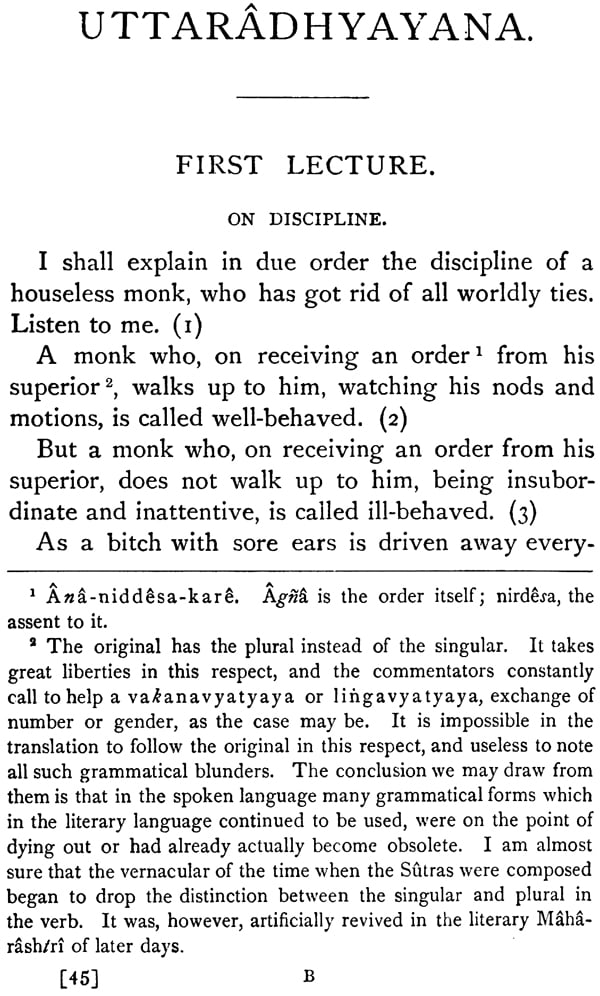
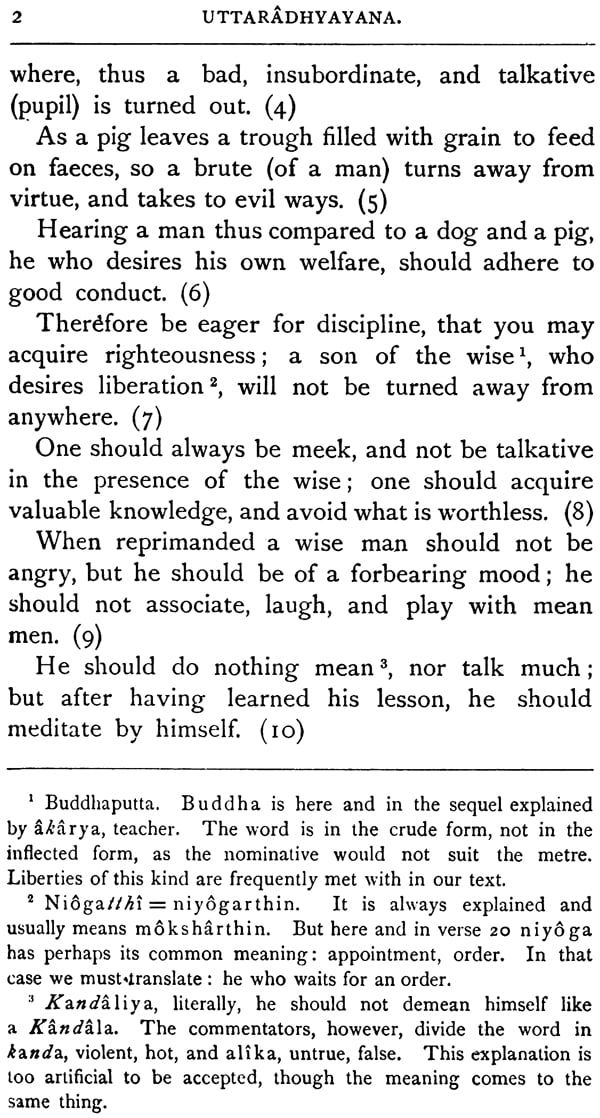
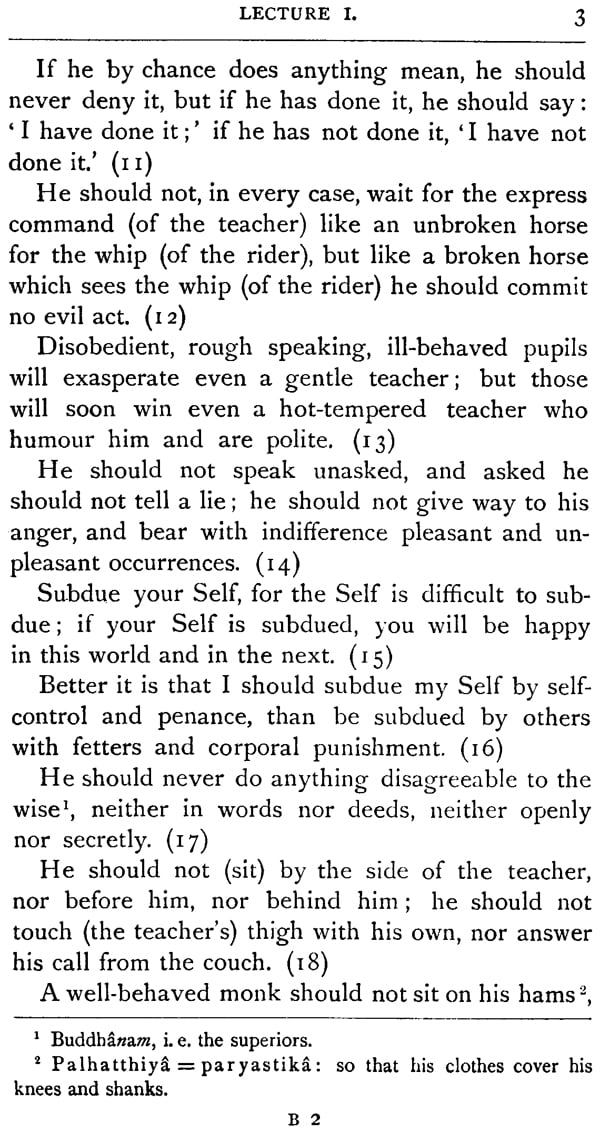
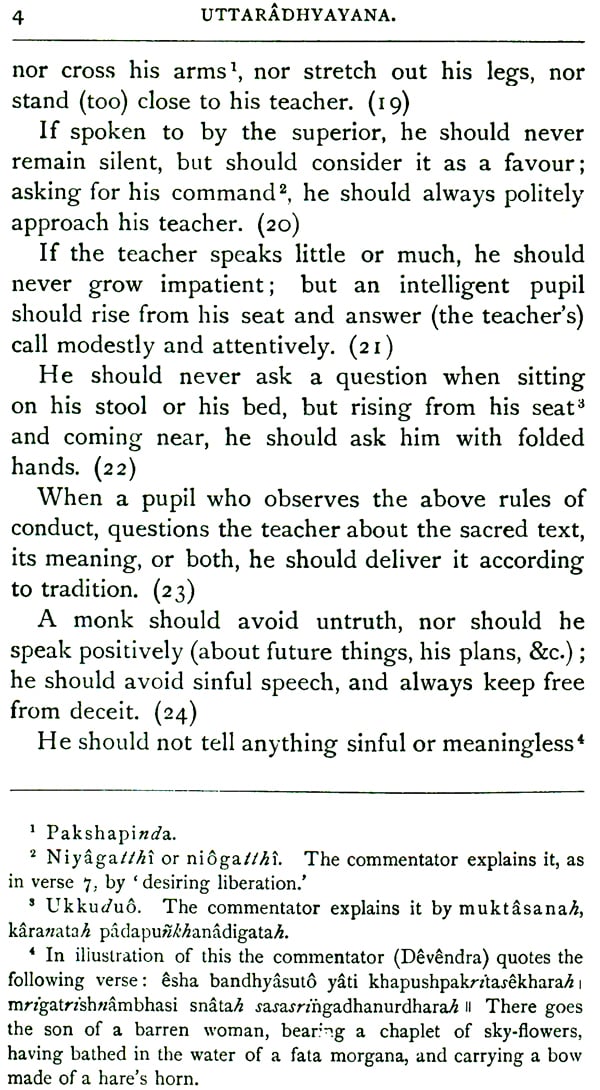

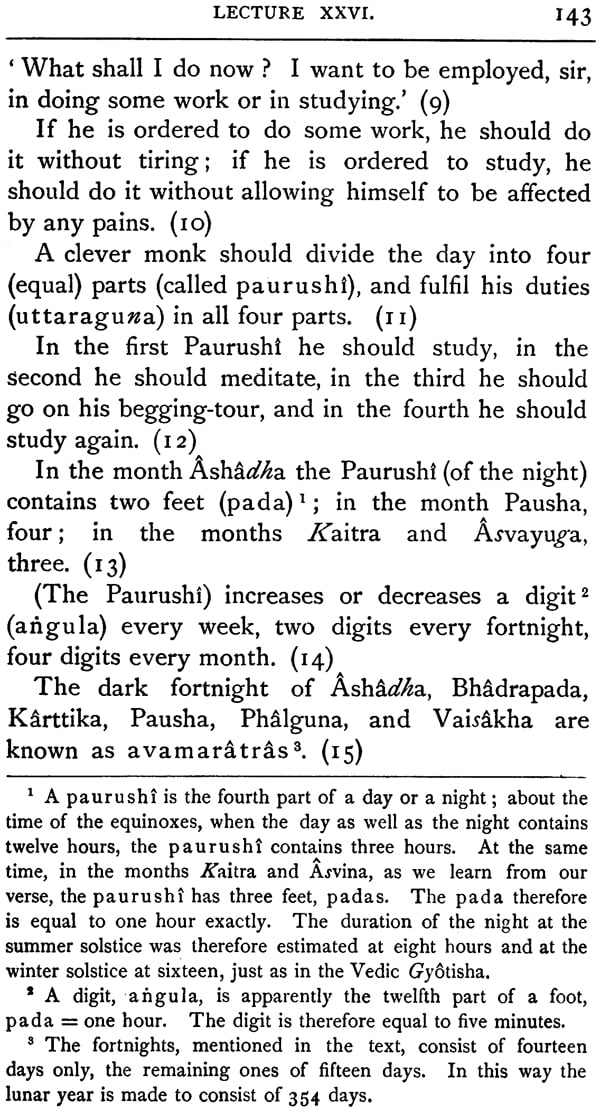

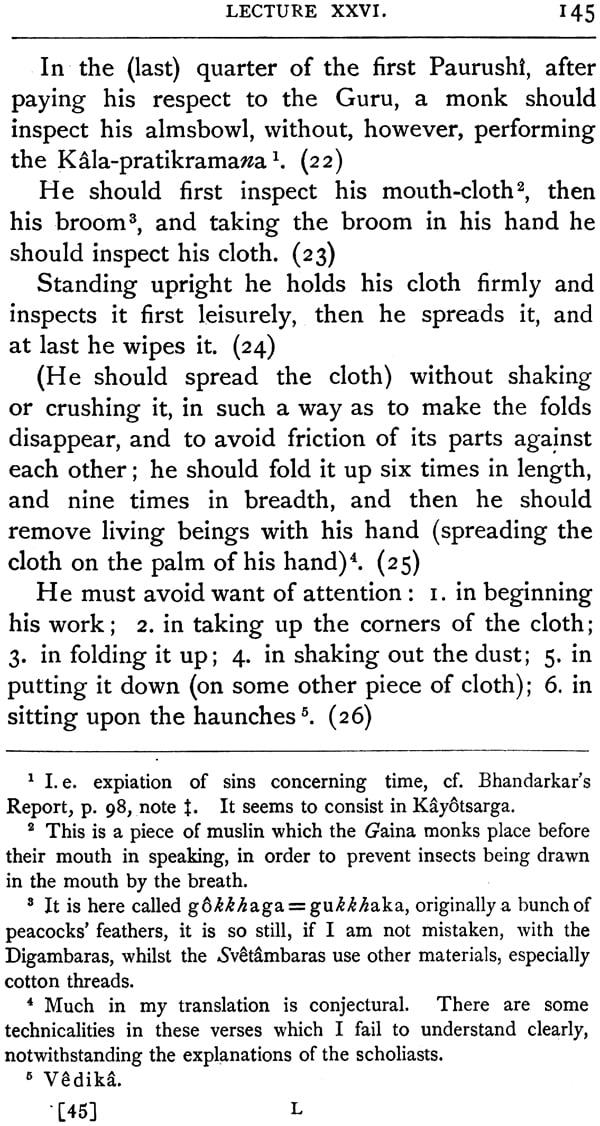
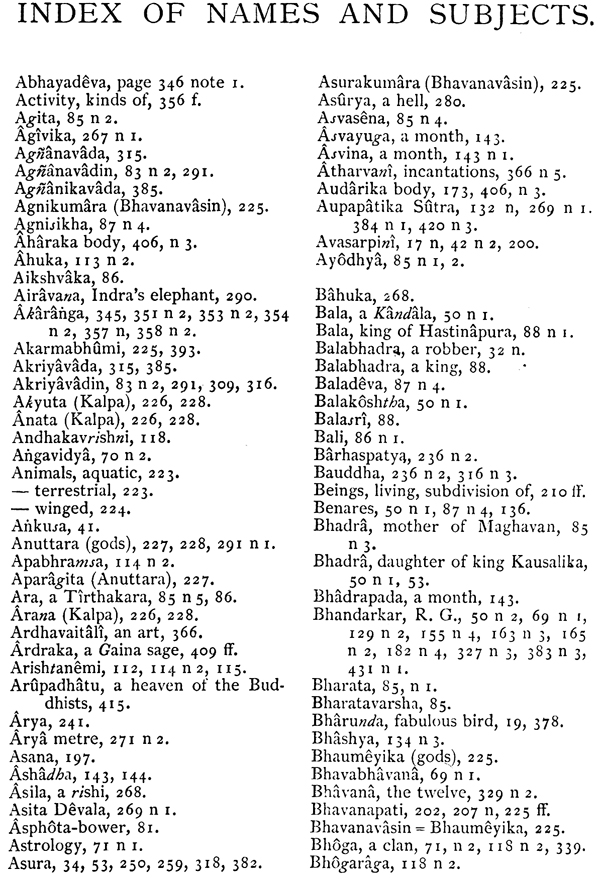



Delivery and Shipping Policy
- INTERNATIONAL SHIPPING
- Rs.1000-1100/kg
- ESTD. Delivery Time: 2-3 weeks (depending on location)
- Bubble Wrapped with Extra Padding
- NATIONAL SHIPPING
- NCR: Rs. 30/half kg
- Standard: Rs. 80/half kg
- Express shipments also available on Request
- ESTD. Delivery Time: Ranging from 1-4 days up to 7 business days (Depending on your choice of Delivery)
- TRACKING
- All orders; national or international, will be provided with a Tracking ID to check the status of their respective orders
- Depending on the Shipping Service, Tracking ID may be used on their respective tracking portals
Frequently Asked Questions (FAQs)
Domestic Shipping: 3-4 Days (after shipping)
International Shipping: 1-2 weeks (based on your location)
You will receive an email once your order has been shipped or you can email us if you didn't receive tracking details (info@mlbd.co.in)
Every book that we sell is the latest edition except all the rare books
Yes, we do provide free shipping, only on domestic orders (within India) above Rs.1500


